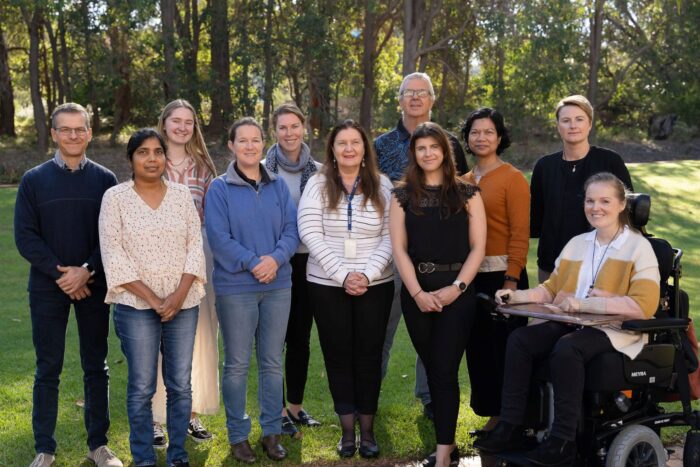An IBM patient-led research project
Editor’s note: This is part one of a three-part series of articles from Dr. Kevin Austin, an Adjunct Professor in the Health Futures Institute’s Personalised Medicine Centre in Murdoch University, Australia. He lives with IBM and turned his research skills toward a study to understand the priorities of those living with myositis and their care partners.
By Kevin Austin
My personal journey began with a chance encounter with a professor of neurology. The doctor watched me struggle to get up from the chair after my consultation and asked me a few additional questions. It turned out that her husband was also a professor of neurology. She mentioned my struggles to her husband over that evening’s dinner. That encounter led to my formal diagnosis of inclusion body myositis (IBM) approximately 10 years ago.
Having a name was a significant step forward as it enabled me to research information about my condition. My professional background was in medical research, computing science, and business marketing and consulting in both the commercial world and not-for-profit spaces. Hence, I was well equipped with the necessary skills to dig deeper.
To my horror, I quickly discovered that very little was known about the disease: there were no known causes, no treatments, and certainly no cures. As I got bumped around the medical system from pillar to post, little was forthcoming from any direction. We joined the Myositis Association Australia, a similar group to TMA here in Australia, and felt an immediate blast of fresh air. We were talking to people who understood our fears, uncertainties, and doubts. The connection led me to meet up with myositis researchers in Perth. In the face of such a dearth of information, I immediately volunteered to work with the Myositis Discovery Programme and the Perron Institute for Neurological and Translational Science at Murdoch University in Perth, Western Australia

The team was led by Professor Merrilee Needham and supported by a medical research nurse, Kelly Beer. Along the way, others joined our journey, including Bill Hawkins from Sydney, originally an engineer by training who also had extensive experience in research. He was our technical guru who spearheaded new techniques of group interaction across the myositis diaspora around Australia.
It turns out, that if you want to really understand what the issues, perceived risks, and challenges faced by patients, carers, and their families, you firstly need a very safe (non-threatening) approach, and secondly, you need to ask them directly. As researchers you also need to have the ability to cope with negativity. People need to feel safe in coming out with what truly bothers them.
Our two-phase study initially involved a small cohort of 23 patients and carers who met in a series of workshops and interviews to identify key challenges (themes). A second phase, involving 200 Australian myositis patients and carers, which included 149 individuals with IBM used an online survey to prioritize these themes and determine their current level of coping.
This process uncovered a set of ten significant priorities for patients and carers. The top ten priorities, in order of importance for both patients and carers, were:
1. Uncertain future: Disease progression, housing needs, and loss of independence
Constant state of uncertainty: not knowing where I am in the overall scheme of things (lack of easy-to-understand disease stages) – what comes next? When should we downsize? Future requirements? How bad will it get? Loss of my independence…can’t even open a jar, having trouble with cutlery etc.
2. Coping with daily frustrations
Coping with the daily grind of managing myositis challenges and issues: toileting (particularly outside the home), swallowing and coughing, general mobility difficulties like needing help getting off chairs, getting in and out of bed, mental and physical fatigue, showering, finding suitable technologies and clothing, getting out and about.
3. Lack of cure, treatment, and understanding
Taking far too long for the medical profession to identify something is wrong. Allied health and general family doctors are largely unaware of myositis. Lack of treatment options. Wishing every day for treatment or something to at least slow the progression. Keeping up with new advances or treatment options. Little understanding of what the patient is actually going through. Lack of a unified view from medical professionals.
4. Impact on carer’s capabilities and own needs
The carer often has their own challenges and has trouble supporting their patient sufficiently. Ability to participate in carers’ own interests is significantly impacted by requirements of caring. Not being physically strong enough to assist the patient. Being realistic and prepared to let go. Burnout.
5. Change of roles and relationships
Roles are changing and feel overwhelmed with assuming new responsibilities such as main breadwinner, home maintenance, driver, carer, strain on relationships with children, grandchildren, partner now more of a carer than lover, loss of intimacy, greater workload around the house with cooking.
6. Getting information, education, and support when needed
Accessing information about high quality clinicians, and therapists in my area. Need for carer support groups and education and training. Lack of treatment coordination. Poor understanding of the complex world of the health system. Particularly poor understanding of myositis within the health system itself, its institutions, clinicians, professionals, and bureaucrats.
7. Significant impact on our mental health
Constant fear and anxiety of falling and its consequences. Frustration with diminished social interaction, not being able to take a break or have holidays. Not knowing who to talk to when feeling in despair. Loss of independence. Ongoing feelings of helplessness, hopelessness and anxiety, often leading to depression.
8. Financial impact
Financial burden and cost of disability aids, products, home and vehicle modifications. Future requirements and budgets are a significant worry.
9. Issues with Australia’s disability and aged care systems
Australian aged care and disability policies are difficult to understand and complex to navigate. Poor understanding of myositis within governments results in difficulty in patients being accepted. Recent floods in Australia have revealed inadequacies in the emergency evacuation protocols with those suffering myositis.
10. Concern not covered by voluntary euthanasia
Wanting the right to choose euthanasia when the time comes. State legislation varies and concern that it may not be covered by our state legislation.
Having discovered what was important to myositis patients and carers, we wanted to find out how people were coping, warts and all. Our second article will reveal what patients, carers, families, and friends struggle with.

Both my sister in law and I have IMB. What is important to us is our christian faith knowing that we can gain strengh to face the future regardless of direction the IBM takes us. Yes times can be tough and I have alway been a hands on person but there is always seems to be someone worst off than you. We can go forward having a hope for the future.
I was diagnosed with IBM 7 years ago. I was overwhelmed when I read those 10 significant issues. Suddenly I was not alone and I felt understood and validated. So much about my IBM is invisible to most except those closest to me. I try so hard to manage, say connected, be involved, be independent, be positive. But it’s really hard, dealing with all the subtle and not so subtle challenges every day. I am so incredibly grateful for this series and for the huge effort that has gone into producing this information
Really interesting to read the 10 points. I was diagnosed with IBM in 2017 and the condition has gradually worsened since then. A particular issue is isolation and feeling alone. As the condition has worsened I am finding it difficult to stand up from my wheelchair and scooter so I rarely leave my home. I am lucky to have a really caring and supportive family.